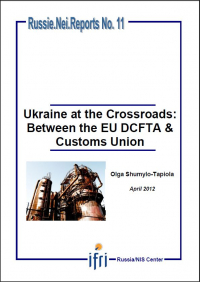Ukraine at the Crossroads: Between the EU DCFTA and Customs Union Russie.Nei.Reports, No. 11, April 2012
After serious decline in the 1990s, Ukraine's economy finally started its recovery and systemic reform in early 2000. While the economy rapidly grew by 2008, its transformation remained unfinished. Ukraine has three possible roads to development.

The first, and least probable, is to stay on its own. The second, and currently most feasible, is to sign an Association Agreement (AA) with the EU that includes a Deep and Comprehensive Free Trade Agreement (DCFTA). The third, and most controversial, choice is to join the Customs Union with Russia, Belarus and Kazakhstan and embark on further Moscow-led integration projects.
Negotiations with the EU are now finalized: the agreement was finally initialed at the end of March 2012. However, further steps, such as signing and ratification of the agreement depend on the Ukrainian side. Ukraine's leadership has repeatedly confirmed the country's interest in signing and ratifying the Association Agreement with the EU. Meanwhile, Russia's invitation to join the Customs Union has been consistently, but politely declined. However, many Western and Russian observers still question the irreversibility and credibility of this decision.
An earlier version of this paper was presented at a conference organized by Ifri in the framework of the Eurasian Trade Task Force (ETTF), 17 October 2011. The ETTF addresses the different commercial and economic integration projects in Eurasia and their impact on domestic and foreign policies of the states concerned.


